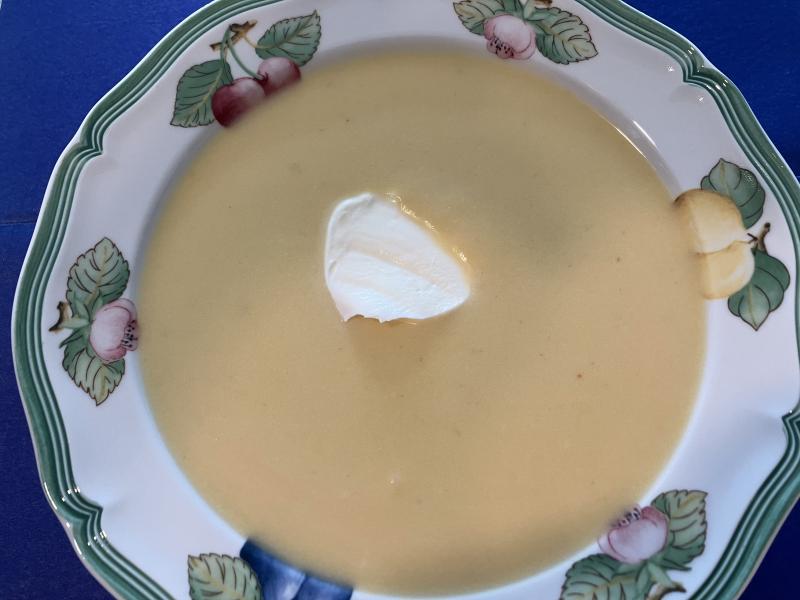Butternut squash is tough but tasty
As I started my research for this week’s column, I recalled an incident from about a year ago. I was sitting in my apartment reading a book and began to hear loud, persistent banging from the unit immediately next door. Wondering if something was amiss, I went over and rang the doorbell. My neighbor, Ann, greeted me with a huge knife in one hand and a hammer in the other. All she said was, “Butternut squash.”
Those of you who have only purchased this vegetable already peeled, cubed and stored in a plastic clamshell box have not faced the challenge of transforming the thick-skinned, tan-hued squash into cubes of orange flesh ready for a recipe. The skins are inedible and hard enough to resist even the sharpest knife blades, hence my neighbor’s double-tool approach.
While winter squash are rugged, they are somewhat misnamed. Grown in the summer and harvested in early fall, they’re technically considered a warm-weather crop. Winter squash (e.g., acorn and butternut) are allowed to mature on the vine, developing tough rinds and large seeds. The word “winter” simply refers to their ability to be safely stored for months in a cool, dark place.
Like many discerning shoppers, we typically look for the freshest produce available, with one exception: Winter squash are one of the few vegetables you can confidently add to your cart, even if they haven’t been freshly picked. And, if you find them at a local farmers market, you can be confident letting them wait until you’re ready to cook them, unlike their summer cousins.
As you may recall from your early history lessons, squash has been cultivated in the Americas for thousands of years. Squash was introduced to the early European settlers by Native Americans, most notably as one of the “three sisters” crops: corn, beans and squash. Corn stalks provided a trellis for the climbing beans, and the squash vines shaded out weeds and helped the soil retain moisture. In addition to their contribution to the overall growing process, squash were important because they could be stored and eaten during the lean winter months.
The flesh of any winter squash needs to be peeled and cooked before incorporating it into a recipe. One advantage butternut squash have over the larger types is how easy they are to prepare for cooking: cut them in half lengthwise, place the pieces in a baking pan and roast until soft. Once they’re ready, the seeds fall away into a tidy pile (unless you’ve already removed them) and the flesh separates readily from the skin.
Puréed squash is an ideal ingredient for a satisfying soup. The result is creamy and low in calories with a rich texture and warm flavor. To give it a spicy kick, you can garnish each bowl with a sprinkle of curry powder or add more creaminess with a dollop of creme fraiche or sour cream. Another popular garnish is a generous spoonful of lump crabmeat.
The elegant butternut is a fine substitute for pumpkin in breakfast muffins, quick breads or pies. But, unlike pumpkins, which are filled with stringy pulp and slimy seeds, butternuts have just a small pocket of seeds inside the base, so they’re easier to core and a great price performer. I’ve included a recipe for the soup in the photo, as well as a roasted squash side dish. Time to sharpen your knives!
Butternut Squash Soup
Melt the butter in a large saucepan. Add onion and apple; sauté until softened, about 5 minutes. Add squash and cook until slightly softened, about 5 minutes. Pour in broth and bring to a boil. Reduce heat and cover; simmer until vegetables are cooked through, about 15 minutes. With a food processor or immersion blender, purée the soup until smooth. Stir in lemon juice and cardamom; finish with salt and pepper, to taste. Serve garnished with creme fraiche.
Roasted Butternut Squash
Preheat oven to 450F. Line a baking pan with aluminum foil and coat with nonstick cooking spray; set aside. Peel and seed the squash, and cut into 1-inch cubes; set aside. In a large bowl, whisk together the olive oil, vinegar and spices. Add the squash cubes and toss to coat thoroughly. Spread the squash in a single layer on the prepared baking pan. Roast for 25 minutes, turn squash with a spatula and cook an additional 20 minutes. Turn once again and continue cooking until nicely browned. Yield: 4 servings.




















































